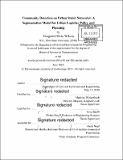| dc.contributor.advisor | Matthias Winkenbach and Yossi Sheffi. | en_US |
| dc.contributor.author | Wilson, Margaret Olivia. | en_US |
| dc.contributor.other | Massachusetts Institute of Technology. Department of Civil and Environmental Engineering. | en_US |
| dc.date.accessioned | 2019-12-13T18:53:40Z | |
| dc.date.available | 2019-12-13T18:53:40Z | |
| dc.date.copyright | 2019 | en_US |
| dc.date.issued | 2019 | en_US |
| dc.identifier.uri | https://hdl.handle.net/1721.1/123238 | |
| dc.description | Thesis: S.M. in Transportation, Massachusetts Institute of Technology, Department of Civil and Environmental Engineering, 2019 | en_US |
| dc.description | Cataloged from PDF version of thesis. | en_US |
| dc.description | Includes bibliographical references (pages 81-86). | en_US |
| dc.description.abstract | This thesis considers the community detection methods employed by network studies in a wide variety of contexts and adapts their use to the segmentation of an urban street network. In order to form partitions of urban street networks that are manageable as delivery territories or similar units of spatial aggregation, e.g., discrete demand zones, to be used in a study of urban freight distribution, extant community detection methods are assessed and adapted. Numerical experiments demonstrate that the sub-networks formed by these partitions display travel properties that make them a useful model for logistics transportation, especially in contexts where continuum approximation methods might be employed. The ratio of simulated trip distances over the actual road network to the idealized distance between the trip endpoints is used as a metric to quantify some travel properties of these segments. | en_US |
| dc.description.abstract | This ratio describes the magnitude of detour required by network conditions, which can offer a proxy for travel efficiency due to road network variations across a city. Using this metric, network-based partitioning algorithms are shown to produce sub-networks with internal travel conditions that are on average more efficient and less variable than sub-networks produced from extant methods of urban segmentation. This result is demonstrated on a wide variety of test networks in cities worldwide. In addition, a secondary use case as a decision-support tool for policymakers is proposed. Since this algorithm creates areas with a flexible spatial resolution in which boundaries are defined by infrastructure and geography, it may constitute a useful way to delineate areas where policy interventions should be employed. | en_US |
| dc.description.abstract | Because the impact and presence of freight traffic vary with local land uses (e.g., commercial, residential, industrial), the land use characteristics of these segments are also investigated to determine if network-based segmentation models capture more variation in land use characteristics than alternative methods. | en_US |
| dc.description.statementofresponsibility | by Margaret Olivia Wilson. | en_US |
| dc.format.extent | 86 pages | en_US |
| dc.language.iso | eng | en_US |
| dc.publisher | Massachusetts Institute of Technology | en_US |
| dc.rights | MIT theses are protected by copyright. They may be viewed, downloaded, or printed from this source but further reproduction or distribution in any format is prohibited without written permission. | en_US |
| dc.rights.uri | http://dspace.mit.edu/handle/1721.1/7582 | en_US |
| dc.subject | Civil and Environmental Engineering. | en_US |
| dc.title | Community detection on urban street networks : a segmentation model for urban logistics policy and planning | en_US |
| dc.type | Thesis | en_US |
| dc.description.degree | S.M. in Transportation | en_US |
| dc.contributor.department | Massachusetts Institute of Technology. Department of Civil and Environmental Engineering | en_US |
| dc.identifier.oclc | 1129597909 | en_US |
| dc.description.collection | S.M.inTransportation Massachusetts Institute of Technology, Department of Civil and Environmental Engineering | en_US |
| dspace.imported | 2019-12-13T18:53:39Z | en_US |
| mit.thesis.degree | Master | en_US |
| mit.thesis.department | CivEng | en_US |
